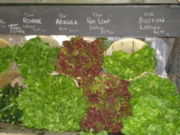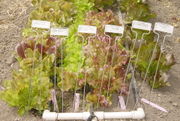Lettuce
2007 Schools Wikipedia Selection. Related subjects: Food and agriculture; Plants
| iLettuce | ||||||||||||||
|---|---|---|---|---|---|---|---|---|---|---|---|---|---|---|
 Iceberg lettuce field in Northern Santa Barbara County
|
||||||||||||||
| Scientific classification | ||||||||||||||
|
||||||||||||||
|
|
||||||||||||||
| Lactuca sativa L. |
| Lettuce (butterhead) Nutritional value per 100 g |
|||||||||||||||||
|---|---|---|---|---|---|---|---|---|---|---|---|---|---|---|---|---|---|
| Energy 10 kcal 60 kJ | |||||||||||||||||
|
|||||||||||||||||
| Percentages are relative to US recommendations for adults. Source: USDA Nutrient database |
|||||||||||||||||
Lettuce is a temperate annual or biennial plant most often grown as a leaf vegetable. In Western countries, it is typically eaten cold and raw, in salads, hamburgers, tacos, and several other dishes. In some places, including China, lettuce is typically eaten cooked and use of the stem are as important as use of the leaf.
The Lettuce plant has a short stem initially (a rosette growth habit), but when it blooms, the stem lengthens and branches, and it produces many flower heads that look like those of dandelions, but smaller. This is called bolting. When grown to eat, lettuce is harvested before it bolts.
Lettuce is used as a food plant by the larvae of some Lepidoptera - see list of Lepidoptera which feed on lettuces.
History
The wild predecessor of our modern lettuce, Lactuca serriola, can still be seen all over Europe and the more temperate parts of Asia. It is likely that it originated on the Mediterranean rim on rocky wasteland or woodland clearings. This ancient wild relative of the modern lettuce contains lactucarium, a narcotic similar to opium. The Romans took advantage of this property by eating lettuce at the end of a meal to induce sleep.
In earlier times the Egyptians held a similar view of the lettuce. However as well as a hypnotic or an aid to sleep, the plant was also linked with male virility. As any vegetable gardener will know the lettuce can bolt or surge vertically upwards. This combined with a milky substance they can exude when cut could have been seen as a symbol of the male phallus ejaculating . It is thought these Egyptian plants were closely linked with the modern day Cos lettuce and could have originated on the Turkish coast opposite the island of Kos.
With the vast number of lettuce cultivars in existence, it is near impossible to pin-point their exact origins. Certainly both the Roman and Egyptian lettuce continued to be eaten long after the two great civilizations started to decline. Many may have hybridised with the wild type serriola to make the modern sativa.
It is certain that these ancient civilizations saw the plant as both an appetite stimulant and an aid to sleep. In ancient Greece this led to confusion whether to eat the plant at the beginning or the end of a meal. The physician Galen, from Pergamon, would eat the plant to allow restful sleep and allow him to study without 'mental churnings' the following day. Somewhat contrary to this, a century earlier, Rufus of Ephesos declared the opposite; claiming lettuce 'fogged the memory and prevented clear thought'.
One of the earliest records of the modern European lettuce was in a piece by Lucas van Valkenborch who showed clear depictions of modern butterhead lettuces in his piece 'Allegory of Summer'.
Cultivars
There are six commonly recognised Cultivar Groups of lettuce which are ordered here by head formation and leaf structure; there are hundreds of cultivars of lettuce selected for leaf shape and colour, as well as extended field and shelf life, within each of these Cultivar Groups:
- Butterhead, also called Boston or Bibb forms loose heads; it has a buttery texture. Butterhead cultivars are most popular in Europe.
- Chinese lettuce types generally have long, sword-shaped, non-head-forming leaves, with a bitter and robust flavour unlike Western types, appropriate for use in stir-fried dishes and stews. Chinese lettuce cultivars are divided into "stem-use" types (called celtuce in English), and "leaf-use" types such as youmaicai (Chinese: 油麦菜; pinyin: yóumàicài) or shengcai (生菜).
- Crisphead, also called Iceberg, which form tight, dense heads that resemble cabbage. They are generally the mildest of the lettuces, valued more for their crunchy texture than for flavour. Cultivars of iceberg lettuce are the most familiar lettuces in the USA. The name Iceberg comes from the way the lettuce was transported in the US starting in the 1920s on train-wagons covered in crushed ice, making them look like icebergs.
- Looseleaf, with tender, delicate, and mildly flavoured leaves.
- Romaine, also called Cos, is a head-forming type with elongated leaves.
- Summer Crisp, also called Batavian, which form moderately dense heads with a crunchy texture; this type is intermediate between iceberg and looseleaf types.
Some lettuces (especially iceberg) have been specifically bred to remove the bitterness from their leaves. These lettuces have a high water content with very little nutrient value. The more bitter lettuces and the ones with pigmented leaves contain antioxidants.
Rocket, also known as arugula, garden rocket, rocket salad, rugola, or roquette[1], is a type of leaf vegetable, and although often mistaken for a sort of lettuce, is in fact an herb, being a member of the mustard family.
Trivia
- The largest lettuce head was one that weighed 11 kg (25 lb), of the Salad Bowl cultivar, grown by Colin Bowcock of Willaston, England, in 1974.
- In the United States, 95% of all head lettuce is grown in California and Arizona.
- On Saturday Night Live
- The October 3, 1998 episode (Season 24, Episode 2) of the television comedy show featured a fake commercial for "KCF Shredders", a hypothetical fast food lettuce meal for hip hop Americans. (KCF was a jab at KFC.)
- The December 3, 2005 episode of Saturday Night Live featured a digital short touting lettuce "through good times and bad".
- Lactucarium (or "Lettuce Opium") is a mild opiate-like substance that is contained in all types of lettuce.
- Yazidis consider eating lettuce taboo. See Taboo food and drink.

